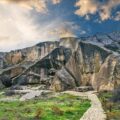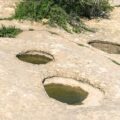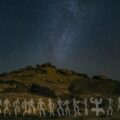- © shutterstock.com, MasyuraN
- © shutterstock.com, Alizada Studios
- © shutterstock.com, In Green
- Каменный лабиринт в Гобустане/ Stone labyrinth in Gobustan. © shutterstock.com, Arkady Zakharov
- Загадочные круглые впадины в скалах вблизи жилищ древних людей/ Mysterious round hollows in the rocks near the dwellings of ancient people. © shutterstock.com, Alizada Studios
- Музей Гобустанского государственного историко-художественного заповедника/ Museum of Gobustan State Historical and Artistic Reserve
- © shutterstock.com, Vastram
Gobustan is a unique place on the territory of Azerbaijan. So many rock carvings are concentrated here that the rocks of Gobustan can be considered a stone book, the pages of which are not always clear to the modern reader. Since 2007, the Gobustan rock art cultural landscape has been included in the UNESCO World Heritage List.
Sea of stones
Gobustan, a geographical region in Eastern Azerbaijan, is a vast territory of gorges, cliffs, and valleys between the southeastern foothills of the Greater Caucasus and the Caspian Sea. Due to the peculiarities of the landscape, the territory received the name Gobustan, or the land of gorges.
A considerable area of Gobustan is a chaotic jumble of rocks. Geologists theorize about their origin as follows: the huge enclosed body of water that emerged from the waters of the ancient ocean began to shrink about 800,000 years ago. Its bed, soft folds of loose loam, was subjected to the impact of wind and rain, and, as a result, deep and broad ridges were formed. Areas of the former seabed, consisting of more durable shell limestone, are preserved in the form of low plateaus, the edges of which have been constantly eroding. Boulders and stones rolling down the slopes eventually created the fantastical landscape that Gobustan researcher Ishag Jafarzadeh described as a “sea of stones.”
This sea of stones that emerged over the centuries created about twenty large and small caves providing shelter for people. On the inner and outer walls of these shelters, drawings of people, animals, and various marks were immortalized.
Rock engravings and settlement sites
The rock engravings of Gobustan were revealed for the first time by prominent Azerbaijani archaeologist Ishag Jafarzadeh in 1939 at the foot of Jingirdagh Mountain and on Yazili Hill, and in 1940, in the region of Boyukdash and Kichikdash Mountains. Systematic study of the rock carvings of Gobustan has been conducted since 1947. On the surface of 1,000 rocks, the contour and silhouette drawings of people, animals, various symbols and inscriptions were discovered. At present, the number of pictures revealed exceeds 6,000, covering the period from the Upper Paleolithic Era to the Middle Ages.
For the number of rock drawings and the diversity of themes and techniques in the drawings, Gobustan may easily be compared to a vast art gallery. According to many historians, this material is important for studies of the spiritual culture and religion of the tribes that inhabited not only ancient Absheron but the whole Caucasus. The myriad themes and narratives as well as the chronological strata of Gobustan rock scenes give evidence of a lengthy human presence in this area.
A treasure trove of rock art
Gobustan petroglyphs belong to different epochs and cover a very long period from the Upper Paleolithic to the Middle Ages. In this respect alone, Gobustan’s book of stone is considered unique among the world’s collections of rock art. Also striking is their extraordinary diversity, a succession of styles, designs, and techniques. The Gobustan rock drawings were made by carving, rubbing, scratching, and chiseling techniques. The main theme of the ancient pictures on the rocks of Gobustan comprises scenes of ancient humans and their way of life related to hunting and fishing. Men and women, armed and unarmed hunters, men riding on horses, boats with men paddling are all depicted.
Proof of Roman occupation
Ancient epigraphical remnants with great historical significance have also been discovered. For instance, an ancient Latin inscription was found on a large rock in the southeastern foothills of Boyukdash Mountain. It gives evidence of the deployment of the twelfth Roman legion and its centurions at the time of Emperor Domitian’s rule in Gobustan (81–96 AD). Written sources mention the Roman invasion of the Trans Caucasus and the struggle of the local nations against the invaders, but this occupation of the Romans in Azerbaijan in the 1st century AD was first documented on this stone. It is difficult to determine the purpose of the invasion, but we know at that time the ancient road running from the Near East and heading north along the western coast of the Caspian Sea passed through here. The inscription reads as follows: “The age of Imperator Domitian Caesar Augustus Germanicus. Lucius Julius Maxim centurion of the 12th Fulminata Legion.” The Emperor Domitian received the title Germanicus in 84 AD.
Musical stones and mysterious cupules
Gobustan’s unique rock engravings and inscriptions are part of a huge cultural layer that began to form millennia ago.
Art appeared in the Upper Paleolithic age, and its development continued in the Mesolithic era. Its forms were not yet diverse, but there was already music, mostly ritualistic in nature.
It is not coincidental that there are petroglyphs on the Gobustan rocks from different periods showing individual and group ceremonial dances reminiscent of Yalli, the contemporary Azerbaijani folk dance. Ancient Gobustan
inhabitants accompanied their holidays, Yalli dances, and other ceremonies with music. This is confirmed by the “ancestor” of ancient musical instruments discovered in the Jingirdagh and Boyukdash Mountains. This instrument is called Gaval Dash, a musical stone that was probably used as a primitive percussion instrument during ritualistic dances. When struck with stones of different sizes, it produces metallic sounds of various tones.
Among the monuments of Gobustan, the oldest shelters and caves, belonging to the end of the Upper Paleolithic era and the Mesolithic period, are concentrated on the upper slopes of Boyukdash and Kichikdash Mountains.
The eleven skeletons found in the Mesolithic site of Firuz arouse particular interest.
Two of them are women and one a child; the others are all male skeletons. A large number of nucleuses (fruit seeds), cutters, knives, traps, microliths, arrowheads, pins, and chisels were found here. Holes in the rock with diameters varying between 5 and 8 cm were found, assumed to have been used to tie animals near the shelters. There are also numerous hollows with diameters from 15 to 40 cm and depths between 10 and 30 cm.
Burial mounds and sacred sanctuaries
Alongside the settlements in Gobustan, various grave monuments, especially numerous Bronze Age mounds, have been explored through archaeological excavations. The Gobustan mounds are typically of circular stone with a separate cover. Skeletal remains, several petroglyphs, Bronze Age archaeological objects, and many anthropomorphic headstones have been found. Megalithic monuments, called dolmens, have also been recorded in Gobustan. These constructions are in the shape of a large stone box covered with a flat plate.
Since 1961, excavations and research of some 40 mounds and kurgans (tumuli) belonging to the Bronze Age and later periods have been conducted by archaeologists F. Muradova and C. Rustamov. They found clay and ceramic dishes, adornments (mainly beaded necklaces from seashells and amulets from river stones), weapons, and other objects.
At present, more than 100,000 archaeological artefacts are stored in the Gobustan Reserve funds. They attract the interest of geologists, botanists, soil scientists, and investigators in other fields of science.
The Gobustan National Historical and Artistic Reserve
The Gobustan National Historical and Artistic Reserve, located on the Absheron Peninsula, 60 km south of Baku, was first established as a State Reserve in 1966 by decree of the Cabinet of Ministers of the Azerbaijan Republic. It comprised 4,530 ha of the Boyukdash, Kichikdash, Jingirdagh mountains and Yazili hill to be taken under protection of the state. The Reserve gained national status in 2007.
The quality, density, and significance of its collection of rock engravings are such that in 2007 the Reserve was inscribed on the UNESCO World Heritage List as Gobustan Rock Art Cultural Landscape. The World Heritage site covers an area of 537 ha.
Deciphering our cultural past
Scientists have been engaged in deciphering the rock carvings of Gobustan for more than three-quarters of a century. Judging by the abundance of petroglyphs found, this work will take many more years as almost every rock drawing is a coded message from past generations of ancient artists. The artists very often applied a new image over an old one to suit their own purpose. They also had their own language. Some of whose characters are clear to us, while other characters still give rise to endless speculation and myriad theories, some quite fantastical.
Research within the project Establishing a Digital Database of Rock Images, launched in Gobustan in 2016, is still in progress. The purpose of the project is to re-document the rocks in the conservation area to create a digital database of Gobustan rock images and a new catalogue. As a result of the 3D photography method, 521 new images were found in Jingirdagh-Yazilytepe, where previously 877 images had been recorded. The newly discovered drawings are mainly goats, deer, lions, various abstract designs, tamgas, and vehicle pictures typical of Yazilytepe. And a completely new monument complex was discovered. In this new area, more than 100 rock images were recorded on 30 rocks.
Perhaps the most important point to be made about Gobustan and its extraordinary rock art is that by carving silhouettes of animals, people, and boats into the rocks with sharp stones primitive humans thus recorded information for the first time and stored it for future generations. It was a true information revolution, a launch pad for the cultural history of humankind. The ancient inhabitants of Gobustan played a very important role here. According to Azerbaijani researchers, the Gobustan records in this book of stone are many thousands of years older than the first pictographic tablets from Mesopotamia.
Source: Ministry of Culture of the Republic of Azerbaijan







